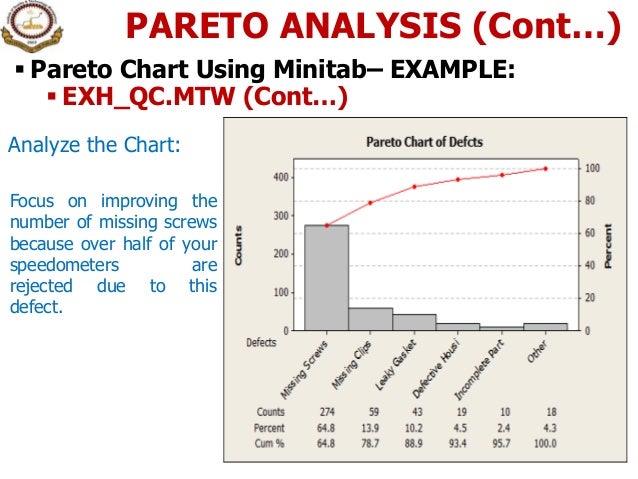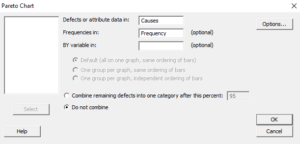
The following table lists the day's inspection results by inspector.
Pareto chart minitab manual#
Bare Board Manual Assembly Manual soldering Visual Inspection Components A checklist of defects is made by inspectors performing the visual inspection. Consider the following hypothetical scenario: At a small company, a simple electronic sub-assembly is manually prepared as follows. In quality applications, the categories are often defect types. The ordering of the bars, from most frequent (highest cost) to least highlights the most significant categories. Transcribed image text: A Pareto chart is a bar chart that depicts the frequency or cost (money, time). Show transcribed image text Expert Answer Potential impact on both the company and customer. Recommending these referring to case information as well as Recommend two defect types that you think should have priorityįor addressing with improvement projects. The important conclusions that you think the manager should be

How do the charts demonstrate the Pareto Principle?Ĭompare the information provided by the two graphs, summarize Use the information to answer the following questions. Redo renaming for the Pareto Chart created for worth instead ofĬheck point: On the Worth Pareto chart, the percent under Solder To change the title, double click on it (or you can right click In the Navigator Pane, choose “Pareto Chart by Defect”. To reduce confusion we will rename each Pareto output. In the Navigator Pane the Pareto Charts may have the same name. (Refer to step 5 if needed.) Your defect or attribute data column Use your data in worth to create a second Pareto chart. Information as to the defect types that are costing us most.ġ. In this step we create a Pareto which provides us with The table, you can edit the graph- click on the labels then theĬheck point: On the frequency Pareto chart, the percent under So that you can more easily see which type goes with the data in Move the cursor to the title area and enter a titleįor your graph “Number of Defects by Type”. Your cursor should now be at Frequencies in. Labels are in C1, so select that from the listing on the right by Move cursor to Defects or attribute data in. Using the frequency data for each defect type.Ĭhoose Stat > Quality Tools > Pareto Chart. You now have the information you need to create a Pareto Diagram Minitab will create a new column called total in the Then click Select toĮnter them into the input variables area. Sum for each of the rows so use your cursor to highlight them byĬlicking on your first data row and dragging the cursor down untilĪll applicable rows are highlighted. That the column names appear in the box on the left. Move the cursor to the Input variables area. Performs the equation you enter and puts the result in the This new variable using Minitab’s calculator. Since you have all the data, you can calculate To build the Pareto chart, we need the total frequencies of eachĭefect type. The Variables box, then use the drop down to Choose

Then put the column you want to change in It, you can change to numeric under Data >Change Data Type. (If a numeric columns happens to have a T on Numericĭata doesn’t have an identifier by it. The “-T” that appeared by the column number. Your defect column is a text column, notice You now have two types of data in your chart. (To make entries going downĪ column, click the data direction arrow to make it point Move your cursor back to column 1, row 1.Įnter the defect types in column 1. With the names of the inspector who collected the data. Label the first column Defect and the next columns Top row (not numbered) is used for the column labels. To make entries going across a row, click the data directionĪrrow (above the row numbers) to make it point to the right. Generated, a line will be added into the navigator so that you can Navigator – After you issue a command and output is

Statistics and graphs after a command is issued.ĭata Pane - is where your data for analysis will beĮntered, edited and viewed. Output Pane - will display output such as tables of The start up screen will contain three panes Minitab Exercise Pareto Chart Mini Case (Rev 1_22,


 0 kommentar(er)
0 kommentar(er)
